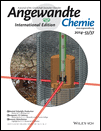UV Excited-State Photoresponse of Biochromophore Negative Ions†
The work was supported by the Carlsberg and Villum Foundations and the Danish Research Agency. A.V.B. acknowledges support through the FP7 Marie-Curie CIG grant and the RFBR (project No. 14-03-00887). This work was granted access to the HPC resources of the Leibniz Supercomputing Center (Garching (Germany)) made available within the Distributed European Computing Initiative by the FP7 PRACE-2IP, as well as to the Lomonosov Supercomputing Center at the Moscow State University. We thank Kyril Solntsev for providing a sample of the meta chromophore.
Graphical Abstract
Higher electronically excited states of the green fluorescent protein chromophore anion have been probed directly by action absorption spectroscopy. The high density of these UV molecular resonances in the UV makes electron detachment in the gas phase efficient. Quantum calculations show this electronic band inside the protein to be resonant with the quasicontinuum of a solvated electron, thus suggesting its major role in the photophysics in the UV region.
Abstract
Members of the green fluorescent protein (GFP) family may undergo irreversible phototransformation upon irradiation with UV light. This provides clear evidence for the importance of the higher-energy photophysics of the chromophore, which remains essentially unexplored. By using time-resolved action and photoelectron spectroscopy together with high-level electronic structure theory, we directly probe and identify higher electronically excited singlet states of the isolated para- and meta-chromophore anions of GFP. These molecular resonances are found to serve as a doorway for very efficient electron detachment in the gas phase. Inside the protein, this band is found to be resonant with the quasicontinuum of a solvated electron, thus enhancing electron transfer from the GFP to the solvent. This suggests a photophysical pathway for photoconversion of the protein, where GFP resonant photooxidation in solution triggers radical redox reactions inside these proteins.





